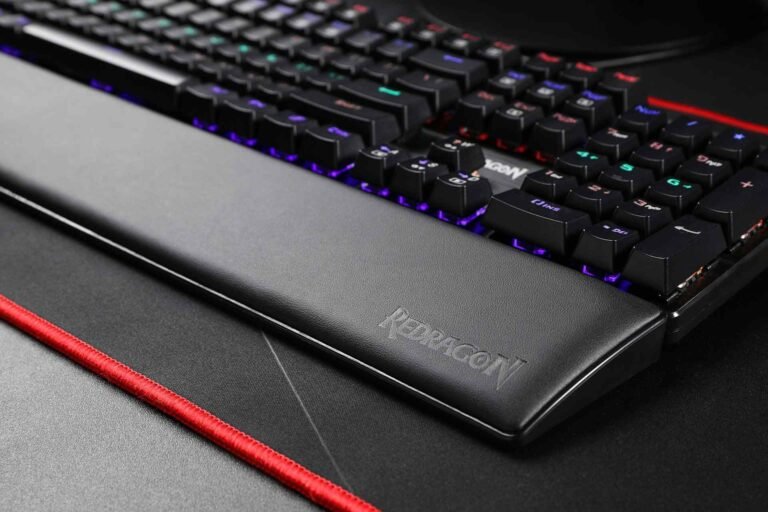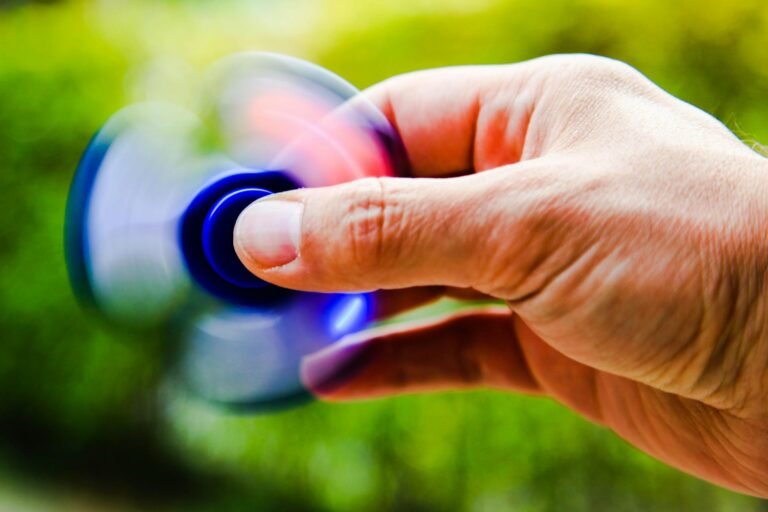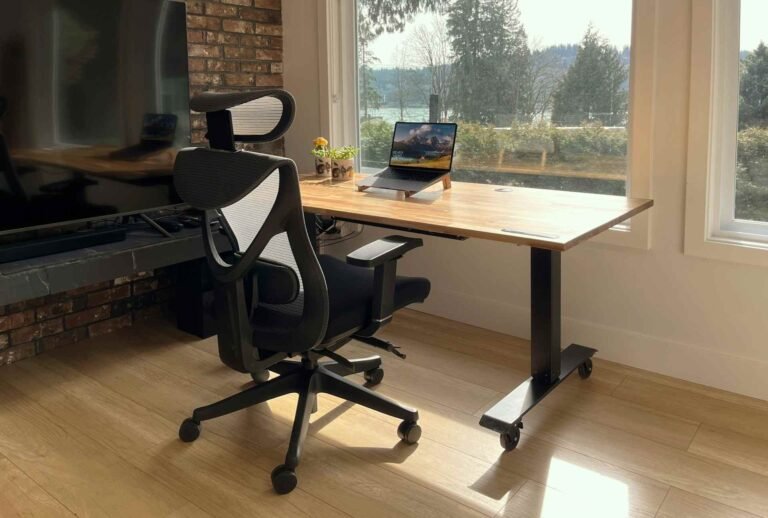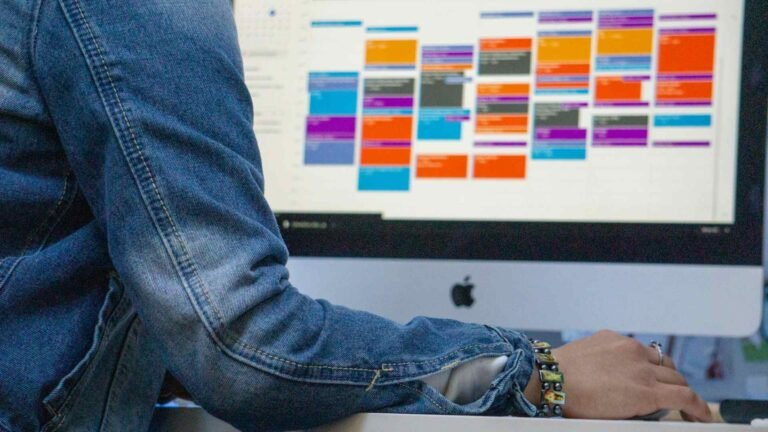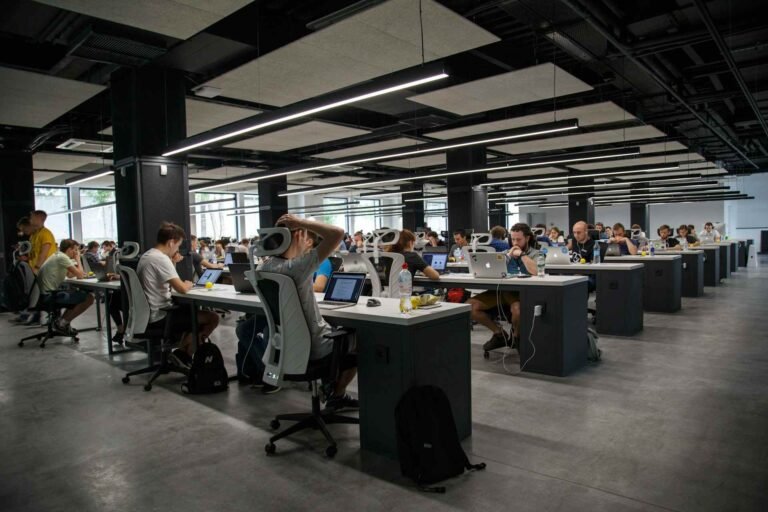Is It Bad to Use a Standing Desk All Day? Expert Tips for Balance
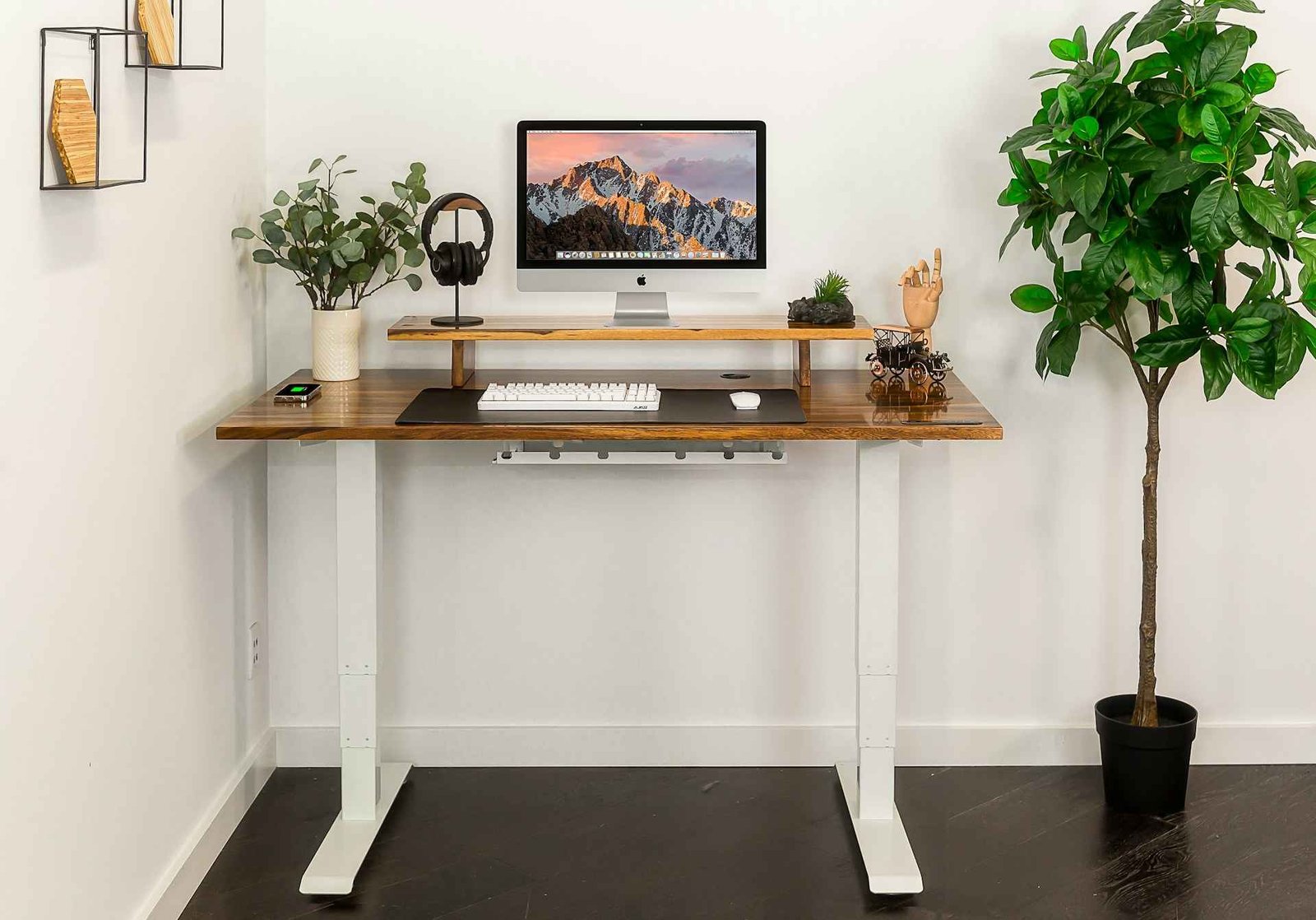
You bought a standing desk with the best intentions. Maybe your back was screaming after years of slouching in an office chair, or perhaps you read somewhere that sitting is the new smoking. So you made the switch, proudly elevating your workspace to new heights. But now, a few weeks in, your legs are protesting, your feet feel like they’ve walked a marathon, and you’re wondering if you’ve simply traded one problem for another.
Let’s settle this once and for all: can you use a standing desk all day without turning yourself into a wobbling mess? The short answer might surprise you.
The Standing Desk Paradox Nobody Talks About
Here’s the thing that most people don’t realize when they first embrace the standing revolution: your body wasn’t designed to stay in any single position for eight hours straight. Whether you’re sitting, standing, or doing a handstand (please don’t try that at your desk), maintaining the same posture for extended periods puts stress on your body in ways that can sneak up on you.
Standing at desks all day seems like the perfect solution to counteract all those years of sitting. After all, you’re burning more calories, engaging your muscles, and feeling more alert. But just like eating too much of even the healthiest food can cause problems, standing for too long comes with its own set of challenges that deserve your attention.
What Actually Happens When You Stand Too Long
Think about the last time you attended a concert or waited in a long line. Remember how your legs started to ache, your lower back began to complain, and you found yourself shifting your weight from foot to foot like you were doing some awkward dance? That’s your body sending you a very clear message: movement is better than static positioning.
When you’re using a standing desk all day without breaks, several things start happening beneath the surface. Blood can pool in your legs, which forces your heart to work harder to pump it back up. Your lower back muscles, which are constantly engaged to keep you upright, can become fatigued and strained. Even your feet and ankles bear the brunt of supporting your full body weight hour after hour.
Some folks develop varicose veins from prolonged standing, while others experience swelling in their legs and feet. Your knees might start to ache, especially if you’re locking them out instead of keeping them slightly bent. And here’s a fun fact that nobody mentions in those enthusiastic standing desk reviews: standing completely still actually creates more muscle tension than walking does.
The Sitting Problem Isn’t What You Think
Before we dive deeper into standing strategies, let’s address why you probably got a standing desk in the first place. The whole “sitting is deadly” narrative got blown a bit out of proportion in recent years. Yes, excessive sitting without movement is associated with various health concerns, but it’s not the sitting itself that’s the villain. It’s the lack of movement and the terrible posture most of us adopt when we sit.
Your spine has natural curves that need support. When you slouch in a chair for hours, staring at a screen with your head jutting forward, you’re putting enormous pressure on your neck, shoulders, and lower back. Add in the fact that many people barely move from their desk except for bathroom breaks and lunch, and you’ve got a recipe for discomfort and potential long-term issues.

But here’s what research keeps showing us: is standing all day bad for you? Absolutely, if you’re doing it wrong. The same principle applies whether you’re sitting or standing. It’s the static nature of the position combined with poor posture that creates problems.
Finding Your Sweet Spot With Movement
The magic formula that health experts keep circling back to isn’t complicated, but it does require some intentionality. Instead of thinking in terms of sitting versus standing, think about creating a rhythm of position changes throughout your day. Your body craves variety and movement, not just different stationary positions.
A good starting point for most people looks something like this: alternate between sitting and standing every 30 to 60 minutes. Some days you might stand more, other days you might sit more, and that’s perfectly fine. The key is listening to your body’s signals rather than following some rigid schedule because you read it on a productivity blog.
When you do stand, you want to maintain good posture just as much as when you sit. Keep your computer screen at eye level so you’re not craning your neck downward. Your elbows should rest at about a 90-degree angle, and your wrists should stay neutral while typing. Anti-fatigue mats (which provide cushioning and encourage subtle movements) can make a huge difference in comfort levels when you’re on your feet.
During your standing sessions, don’t just plant yourself like a statue. Shift your weight between feet, do some gentle calf raises, or take a few steps in place. These micro-movements keep your blood flowing and prevent that locked-up feeling that comes from rigid standing. Speaking of movement, incorporating tools that encourage active sitting or standing can transform your workspace experience.
The Accessories That Actually Make a Difference
Not all standing desk experiences are created equal, and the right supporting equipment can mean the difference between loving your setup and abandoning it after two weeks of sore feet.
Adjustable height desks (the kind that let you switch between sitting and standing positions easily) remove the friction from changing positions throughout the day. If you have to manually crank your desk up and down or move everything around to switch positions, you’re much less likely to do it consistently. The easier you make the transition, the more likely you are to actually alternate positions.
Quality footwear matters more than you might think when standing at work all day. Those cute flats or dress shoes might look professional, but if they don’t provide adequate arch support and cushioning, your feet will revolt. You don’t need to show up in hiking boots, but investing in shoes designed for standing comfort pays dividends.
Balance boards or wobble cushions can keep your muscles engaged and prevent that statue-like standing that causes so many problems. They’re not for everyone, and you definitely shouldn’t use them all day, but incorporating them for short periods can add beneficial movement to your standing time.
Standing Desk Accessories Comparison
| Accessory Type | Primary Benefit | Best For | Consideration |
|---|---|---|---|
| Anti-Fatigue Mat | Reduces foot and leg strain | Extended standing periods | Thickness and material quality matter |
| Footrest | Encourages position changes | Alternating foot elevation | Works for both sitting and standing |
| Monitor Arm | Maintains proper screen height | Both sitting and standing positions | Adjustability is key |
| Balance Board | Engages core muscles | Short standing intervals | Takes practice to use comfortably |
| Keyboard Tray | Keeps wrists neutral | Proper ergonomic positioning | Must adjust with desk height |
Warning Signs Your Body Is Sending You
Your body is actually pretty good at communicating when something isn’t working, but we often ignore the signals until they become screaming problems. When you’re experimenting with standing desk usage, pay attention to these red flags that suggest you need to adjust your approach.
Lower back pain that gets progressively worse throughout the day usually means your standing posture needs work or you’re standing too long without breaks. Sharp pain is different from the general fatigue of using muscles that aren’t accustomed to standing work, so don’t just push through serious discomfort hoping it’ll get better.
Swelling in your feet and ankles, especially if it’s accompanied by a heavy or tired feeling in your legs, indicates that blood flow isn’t returning efficiently from your lower extremities. This is a sign to sit down, elevate your feet for a few minutes, and reassess how long you’re standing at a stretch.
Varicose veins or the appearance of spider veins might develop over time with excessive standing. These aren’t just cosmetic concerns but indicators that the veins in your legs are under stress from prolonged pressure.

Joint pain in your knees, hips, or ankles that persists or worsens means your body needs more variety in positioning or better support through proper footwear and anti-fatigue mats. Neck and shoulder tension often points to screen positioning issues rather than standing itself, but it’s worth addressing regardless.
The Movement Solutions Everyone Overlooks
Here’s what makes the biggest difference in whether using a standing desk all day works for you or becomes another abandoned wellness trend: building genuine movement into your routine, not just standing instead of sitting.
Every hour or so, take a real break that involves actual walking. Get up to refill your water bottle, take a lap around the office, or step outside for a minute of fresh air. These brief movement breaks do more for your health than simply standing at your desk ever could. They get your heart rate up slightly, stretch different muscle groups, and give your mind a refresh that often leads to better focus when you return.
Stretching while you work doesn’t have to mean rolling out a yoga mat in your cubicle. Simple movements like rolling your shoulders, doing a standing quad stretch, or reaching your arms overhead can release tension and keep your body happy. Set a reminder if you need to, because when you’re deep in work mode, hours can slip by without any position changes.
Walking meetings might sound like productivity theater, but they’re actually brilliant for combining movement with work. If you’re on a phone call or brainstorming session, there’s no rule that says you have to be planted at your desk. Some of the best problem-solving happens when your body is in motion.
Consider investing in tools that make staying active easier throughout your day. Ergonomic accessories (like keyboards and mice designed to reduce strain) can minimize fatigue, while proper lighting reduces eye strain that contributes to overall tiredness.
The Research Without the Hype
When you cut through all the marketing claims and wellness trend noise, what does science actually tell us about standing desks? The research paints a more nuanced picture than either the enthusiastic advocates or the skeptical critics would have you believe.
Studies consistently show that alternating between sitting and standing throughout the day can reduce discomfort and may improve certain health markers compared to sitting all day. The key word there is “alternating” because the benefits come from variety and movement, not from simply swapping one static position for another.
The calorie-burning advantage of standing versus sitting exists but isn’t as dramatic as some sources claim. You’ll burn a modest amount of extra calories while standing, roughly equivalent to a very slow walk, but this shouldn’t be your primary motivation for using a standing desk. The real benefits relate more to posture, circulation, and energy levels than to weight management.
Research also suggests that standing more during the day might help with blood sugar management and cardiovascular health markers, but these benefits appear to be linked to reducing total sedentary time rather than standing in one spot for hours. Moving around every 30 minutes or so seems to be more important than whether you’re sitting or standing during work periods.
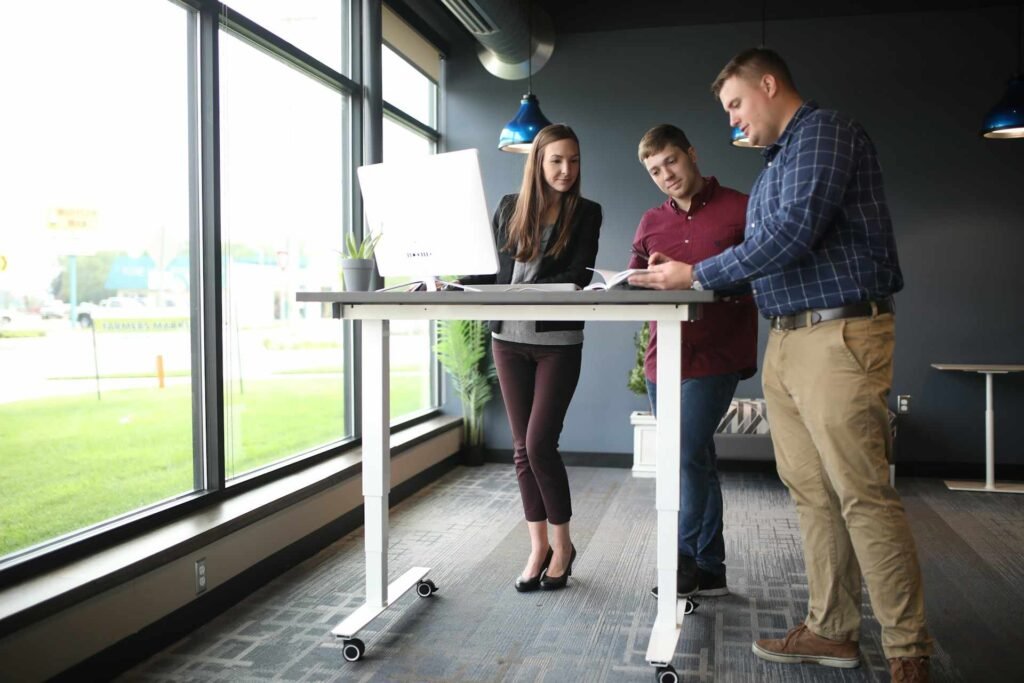
Is standing at work all day bad for you according to studies? Occupational research on workers who stand for their entire shifts, like retail employees or surgeons, shows increased risk of various musculoskeletal issues and circulatory problems. This suggests that all-day standing without adequate breaks or movement isn’t ideal, just as all-day sitting isn’t ideal.
Smart Tech and Tools That Support Healthy Habits
Technology can actually help you maintain better workspace habits if you use it strategically. Various apps and devices can remind you to change positions, track your sitting and standing time, or guide you through quick stretches without being annoying about it.
Some standing desks come with built-in reminders that gently prompt you to raise or lower the desk at set intervals. These can be helpful when you’re first building the habit of alternating positions, though you might eventually turn them off once the rhythm becomes natural.
Simple smartphone timers work just as well as fancy apps if you prefer a low-tech approach. Set a repeating alarm for every 45 minutes or whatever interval works for you, and use that as your cue to assess your current position and whether it’s time for a change.
USB-powered accessories (like desk lights that reduce eye strain) can make your standing and sitting work sessions more comfortable without adding cable clutter to your setup. Better lighting means less tension in your neck and shoulders as you lean forward to see your screen.
For those who get so absorbed in work that they forget to move for hours, wearable devices (that track activity and send gentle reminders) can provide the nudge you need without being intrusive. The goal isn’t to become obsessed with hitting certain numbers but rather to build awareness of how long you’ve been in one position.
Common Mistakes People Make With Standing Desks
Even with the best intentions, it’s easy to fall into patterns that undermine the benefits of your standing desk setup. Recognizing these common pitfalls can help you avoid them from the start.
The all-or-nothing approach ranks as the biggest mistake. People get excited about their new standing desk and immediately try to stand for their entire workday, leading to exhaustion and discomfort that makes them abandon the desk entirely. Remember, moderation and gradual progression work better than extreme changes.
Poor posture while standing defeats much of the purpose. Leaning heavily on the desk, locking your knees, slouching your shoulders forward, or letting your head tilt toward the screen all create strain that can actually be worse than sitting. Your standing posture deserves as much attention as your sitting posture.
Wearing the wrong shoes might seem minor, but it makes a massive difference. Those office shoes might be fine for walking from your car to your desk, but standing in them for extended periods can lead to foot pain, leg fatigue, and even changes in your gait. If you’re serious about using your standing desk regularly, invest in appropriate footwear or keep a comfortable pair at your desk.
Forgetting to adjust everything when you switch between sitting and standing causes ergonomic nightmares. Your monitor height, keyboard position, and mouse placement all need to change when you change your desk height. Taking these extra seconds to adjust properly prevents neck and shoulder strain.
Ignoring your body’s feedback and pushing through pain because you read that standing is healthier can lead to real problems. Discomfort that persists or worsens is a signal to change something, not a challenge to overcome through sheer willpower.
Building a Workspace That Moves With You
The future of healthy work habits isn’t about finding the perfect static position but rather creating an environment that encourages and facilitates movement throughout your day. Your standing desk is just one tool in a larger strategy for staying comfortable and healthy while you work.
Think about your entire workspace ecosystem. Can you easily switch between sitting and standing? Do you have space to do a quick stretch or walk in place? Are there visual cues that remind you to move, or does your setup actually discourage position changes because they’re too much hassle?
Adjustable chairs (that support good posture when you do sit) matter just as much as your standing desk. Many people focus all their attention and budget on the desk itself and then plop down in a cheap chair that undermines their sitting sessions. Both positions deserve proper support.
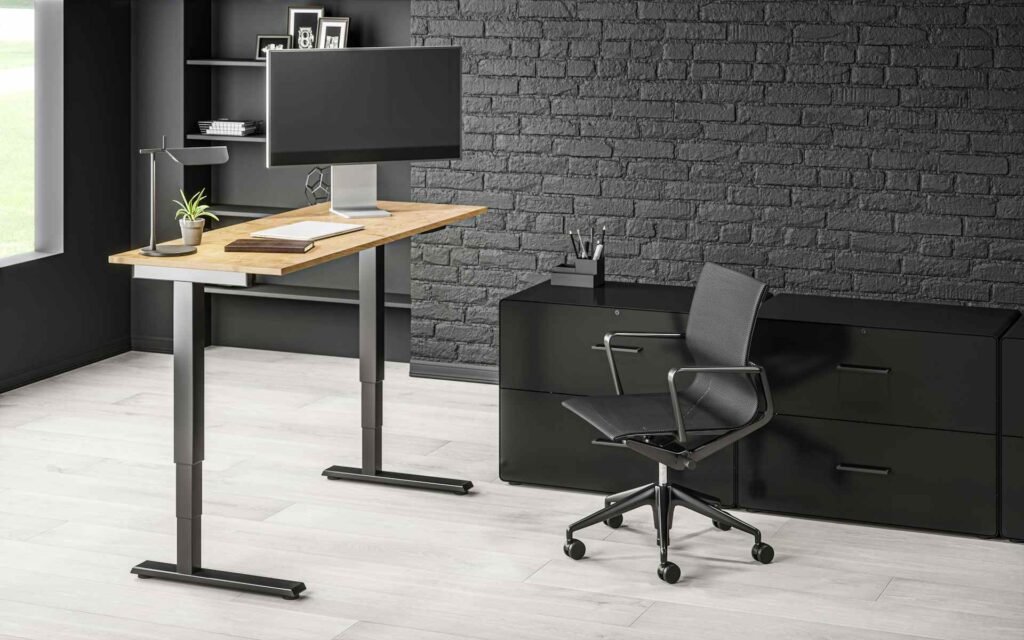
Consider creating different zones in your workspace for different types of tasks if you have the space. Maybe you have a standing area for quick tasks and emails, a sitting area for focused deep work, and a comfortable spot for reading or brainstorming. This natural variation in where you work encourages the movement and position changes your body needs.
The small details add up to create either a friction-filled or a flowing work experience. Things like having your water bottle within reach, keeping frequently used items at varying heights, and setting up your space so that you naturally move around during the day all contribute to a healthier overall pattern.
FAQ
How long should you stand at a standing desk?
Most ergonomic experts suggest starting with 15 to 30 minutes of standing per hour and adjusting based on your comfort level. The goal is to alternate between sitting and standing throughout the day rather than standing for extended periods. Listen to your body and increase standing time gradually as you build stamina. A good target for many people is a 1:1 or 2:1 sit-to-stand ratio, meaning you stand for 20 to 30 minutes for every 30 to 60 minutes of sitting.
Can using a standing desk all day cause leg problems?
Yes, standing in one position for an entire workday without breaks can lead to various leg issues including swelling, varicose veins, joint pain, and muscle fatigue. The key is movement and position variation rather than replacing eight hours of sitting with eight hours of standing. If you experience persistent leg pain, swelling, or circulation issues, you’re likely standing too long without breaks or need better footwear and support.
Is it better to sit or stand while working?
Neither sitting nor standing all day is ideal. The healthiest approach combines both positions with regular movement breaks. Alternating between sitting and standing every 30 to 60 minutes, combined with brief walks or stretches each hour, provides the variety your body needs. The “best” position is actually the next position, meaning frequent changes matter more than which position you’re currently in.
Should you wear special shoes for a standing desk?
While you don’t need special standing desk shoes, supportive footwear makes a significant difference in comfort. Look for shoes with good arch support, cushioning, and a slight heel-to-toe drop. Avoid completely flat shoes without support, high heels, or shoes that compress your toes. Some keep a comfortable pair of sneakers or supportive flats at their desk specifically for standing work sessions.
Does standing at your desk really burn more calories?
Standing does burn more calories than sitting, but the difference is modest, roughly 8 to 10 calories more per hour. Over a full workday, this adds up to maybe 50 to 70 extra calories, equivalent to a small apple. While this isn’t nothing, the real benefits of using a standing desk relate more to improved posture, circulation, and energy levels rather than significant calorie burning.
Making It Work for the Long Haul
So here we are, back to the original question: should you use a standing desk all day? The answer is a friendly but firm no. Standing all day isn’t a healthy solution any more than sitting all day is. But using a standing desk as part of a movement-rich workday? That’s where the magic happens.
The best workspace setup is one that you’ll actually use consistently over months and years, not just during an initial burst of enthusiasm. This means finding a rhythm that feels sustainable, comfortable, and natural rather than following some rigid prescription you read in an article (even this one).
Your body is built for movement, variety, and adaptability. When you honor those needs by alternating positions, taking movement breaks, and paying attention to your body’s signals, you’ll likely find that your standing desk becomes a valuable tool rather than another source of discomfort. And isn’t that the whole point?
Start where you are, make small adjustments, and give yourself permission to experiment until you find what works for your unique body and work style. There’s no standing desk police checking whether you’re following the rules perfectly. The goal is simply to feel better and work more comfortably throughout your day.
Now if you’ll excuse us, we’ve been sitting while writing this article for way too long. Time to stand up, take a walk, and practice what we preach.
Looking for more? Check out our productivity tools category for more articles and guides that may interest you!
Featured image credit: Photo by EFFYDESK on Unsplash
This content is for informational purposes only. Please verify current information directly on the retailer’s site before purchasing.
References:
Aadahl M, Linneberg A, Møller TC, Rosenørn S, Dunstan DW, Witte DR, Jørgensen T. Motivational counseling to reduce sitting time: a community-based randomized controlled trial in adults. Am J Prev Med. 2014 Nov;47(5):576-86. https://doi.org/10.1016/j.amepre.2014.06.020
Bull FC, Al-Ansari SS, Biddle S, Borodulin K, Buman MP, Cardon G, Carty C, Chaput JP, Chastin S, Chou R, Dempsey PC, DiPietro L, Ekelund U, Firth J, Friedenreich CM, Garcia L, Gichu M, Jago R, Katzmarzyk PT, Lambert E, Leitzmann M, Milton K, Ortega FB, Ranasinghe C, Stamatakis E, Tiedemann A, Troiano RP, van der Ploeg HP, Wari V, Willumsen JF. World Health Organization 2020 guidelines on physical activity and sedentary behaviour. Br J Sports Med. 2020 Dec;54(24):1451-1462. https://doi.org/10.1136/bjsports-2020-102955
Dunstan DW, Kingwell BA, Larsen R, Healy GN, Cerin E, Hamilton MT, Shaw JE, Bertovic DA, Zimmet PZ, Salmon J, Owen N. Breaking up prolonged sitting reduces postprandial glucose and insulin responses. Diabetes Care. 2012 May;35(5):976-83. https://doi.org/10.2337/dc11-1931
Prince SA, Cardilli L, Reed JL, Saunders TJ, Kite C, Douillette K, Fournier K, Buckley JP. A comparison of self-reported and device measured sedentary behaviour in adults: a systematic review and meta-analysis. Int J Behav Nutr Phys Act. 2020 Mar 4;17(1):31. https://doi.org/10.1186/s12966-020-00938-3

